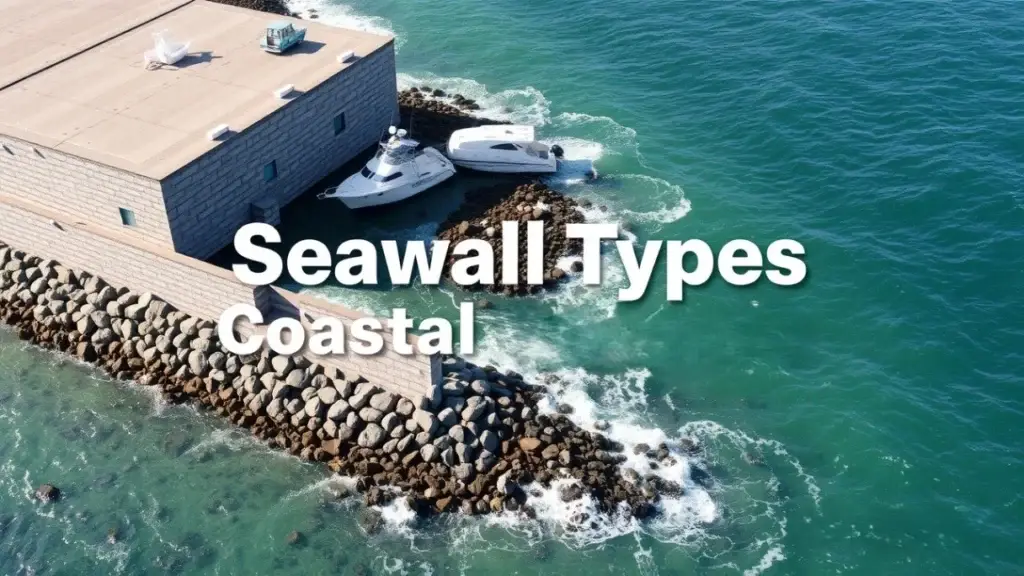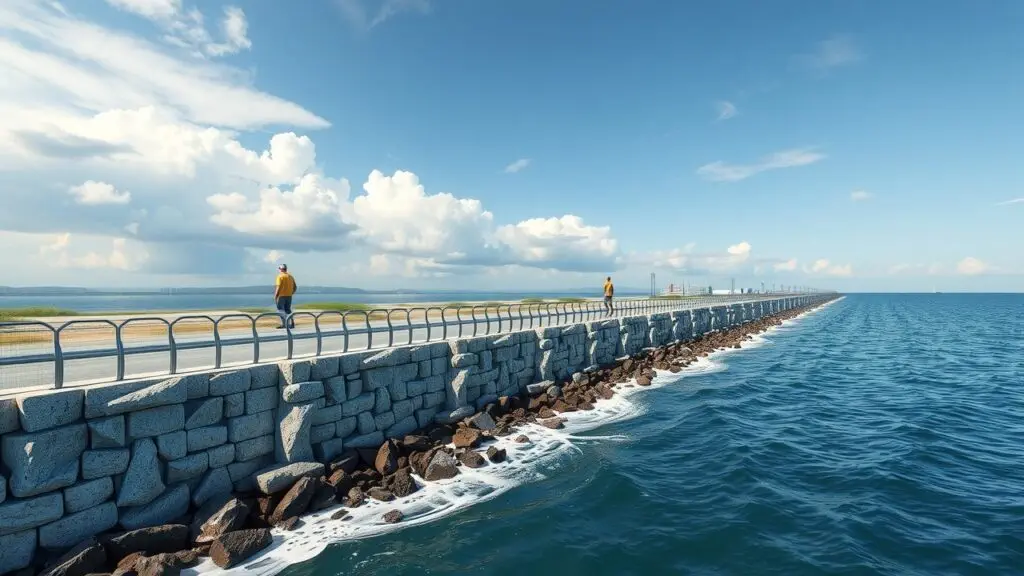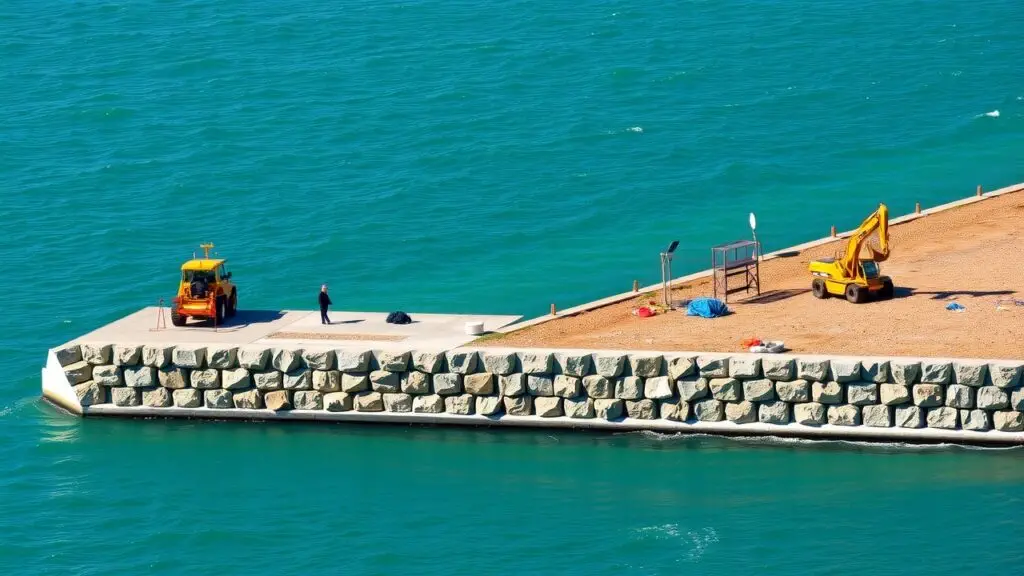Different types of seawalls provide coastal erosion control and shoreline stabilization. This guide helps homeowners understand seawall construction, materials, and the best choices for their waterfront property.
What Are Seawalls and Why Are They Important?

Seawalls are strong structures built along coastlines. They help protect the shore from erosion, flooding, and wave damage. These coastal defense systems act like barriers between land and sea. They work to keep shorelines stable and prevent losing property or habitats because of rising water levels or storms.
The main purpose of seawalls is coastal erosion control. They absorb wave energy, which reduces the waves’ impact on beaches and cliffs. This helps keep shorelines safe during storms or high tides. Seawalls also play an important role in flood prevention. They shield low-lying areas from tidal forces that could cause flooding.
It’s important to choose the right type of seawall for effective protection. Different types work better in different places. Factors like local wave energy, soil type, and existing ecosystems matter a lot in seawall design. A well-designed seawall helps protect the shoreline while being friendly to marine life.
Key Factors Influencing Seawall Selection
When picking a seawall design, there are some key factors to think about:
- Environmental Factors: The strength of waves at a spot affects which seawall type is best. Areas with strong waves might need sturdier designs like vertical seawalls that can handle more force.
- Budget Considerations: The cost to build a seawall can change a lot between types. People planning these projects must think about both what it costs to build and what it will cost to maintain over time.
- Long-term Sustainability: It’s good to think about how each design will affect local ecosystems over time. Some materials may hurt the environment less than others; so choosing sustainable options can help protect natural habitats while managing coastlines.
By looking closely at these factors—environmental conditions, budget limits, and sustainability—people can make smart choices about which types of seawalls will give the best protection for their coastlines without harming the environment around them.
Types of Engineered Seawalls Explained
Gravity Seawalls Overview
Gravity seawalls are strong walls that protect coastlines from erosion and waves. They depend on their weight to hold back the water, making them useful in many coastal areas.
What Is a Gravity Seawall?
A gravity seawall is a tall wall that stands straight up. It uses its heavy materials to resist the pushing force of waves and soil behind it. These engineered structures often use concrete or stone to ensure they stay strong against harsh weather. Special structural analysis checks if they can last over time.
Materials Used in Gravity Walls
Gravity walls usually use tough materials like concrete and stone blocks. Concrete is popular because it lasts long and is very strong. Stone gives a nice look and is also durable. The type of material used affects how well the wall works and how much care it needs.
Best Applications
Gravity seawalls work best in places where big waves hit hard, like busy urban areas facing serious erosion problems. Their design makes them great for spots that need strong protection against storms and rising tides.
Advantages vs Disadvantages
Gravity walls last a long time thanks to solid materials like concrete and stone. But they can be more expensive than other options. Also, they might change the natural look of the shoreline, which can affect local wildlife.
Retaining Walls in Coastal Defense
Retaining walls play an important role in keeping land safe near the coast by stopping soil from washing away.
How Do Retaining Walls Work?
Retaining walls act like barriers that hold back soil or rocks from falling into water during storms or heavy rain. They help keep the land stable next to rivers and lakes, allowing people to use those lands safely.
Common Materials Used
Common materials for retaining walls include timber for smaller projects since it’s cheaper and gabions filled with rocks for bigger ones needing drainage. Each material has its own advantages depending on what the site needs and how it should look.
Where Are Retaining Walls Effective?
These walls are most helpful in calm water areas where gentle waves don’t put too much pressure on them but still need support against erosion—like lands developed near reclaimed waters.
Pros & Cons
While retaining walls can save money and are pretty durable, they may struggle under severe weather conditions unless designed well from the start.
Interlocking Block Systems
Interlocking block systems are easy-to-install solutions perfect for quick protection along coastlines threatened by erosion.
What Are Interlocking Concrete Blocks? Modular Solutions Defined.
Interlocking concrete blocks fit together without needing glue or mortar. This helps build them fast at construction sites while keeping them stable under weight through their clever design that locks them together tight!
Examples & Case Studies
Cities worldwide have used interlocking block systems because they speed up construction times. Places like waterfronts have used these blocks well, whether in sunny regions facing floods or cold areas with snowstorms damaging structures.
Sheet Pile Walls
Sheet pile walls are flexible and watertight barriers made for tough ground conditions near coastlines today!
What are Sheet Pile Walls?
Sheet pile walls consist of thin sections pushed deep into the ground to create continuous barriers that resist forces from soil and water around them, making sure they leak very little during their use!
Materials Used in Sheet Pile Walls
These walls usually use steel sheets known for their resistance to rust, which helps them last longer even in rough ocean conditions. Vinyl sheets also work as lighter choices depending on what project needs most based on costs.
Best Applications
They’re best for deep-water areas like ports needing solid foundations to handle shifting sand patterns naturally over time, plus different soil types affecting overall success after installation is done!
Advantages vs Disadvantages
The main advantage is their excellent watertight properties that protect what’s behind them. However, there are risks of rusting if less durable materials get picked, leading to higher upkeep costs later on as challenges arise!
What Are Hybrid Seawalls?
Hybrid seawalls are special coastal defense structures. They mix traditional engineering with natural features. This helps fight erosion while being friendly to the environment. For example, engineers might use a strong concrete wall and add plants on the slopes. This not only looks nice but also helps animals find homes.
The design of hybrid seawalls aims for sustainability. These structures use materials that do not harm the ecosystem as much as regular seawalls do. When plants are part of the structure, they can help keep soil in place and absorb wave energy. This is super helpful for keeping shorelines stable.
Key Features of Hybrid Seawalls
- Strong Performance: They are built to handle big waves without breaking.
- Nature Benefits: Adding plants helps local wildlife by giving them a place to live.
- Looks Good: Hybrid designs often blend in better with nature than plain concrete walls.
So, hybrid seawalls offer a smart way to protect coastlines. They balance human needs and care for the environment. Their mix of strength and natural features makes them great for stopping erosion.
Examples of Successful Hybrid Systems
Many places have successfully used hybrid seawalls, showing how effective they can be. Here are some examples:
- California’s Coastal Parks: In California, some beaches now have hybrid designs. These walls combine rock layers with local plants. This setup helps break waves and supports different species along the shore.
- Florida Shoreline Restoration: A project in Florida added artificial reefs to a concrete wall system. These reefs lessen wave damage and create homes for fish and other sea creatures.
- New Jersey Resilience Project: New Jersey built interlocking block walls next to sandy dunes that have grasses and shrubs. This combo gives strong protection during storms while helping the dunes stay healthy with plant growth.
By looking at these examples, we can learn how important it is to adapt designs to fit each location. Also, getting feedback from the community during planning leads to better results in stopping shoreline erosion using hybrid methods.
Natural Alternatives to Traditional Engineered Structures
Natural “Living” Shorelines Explained
Natural “living” shorelines use plants, sand, and rocks to protect coastlines. Unlike traditional seawalls that can harm the environment, living shorelines stabilize the coast while helping local wildlife. They include features like vegetative dunes and beach nourishment approaches. These elements work together to absorb wave energy and control erosion. Living shorelines provide a way to protect against erosion without causing ecological harm.
Benefits of Living Shorelines
Living shorelines offer great benefits for the environment and communities. Here are some of the key advantages:
- Better Wildlife Habitat: The plants in these areas give food and shelter to many animals, making them thrive.
- Resilience to Storm Surges: Living shorelines can adjust as sea levels change or weather becomes more intense, helping areas deal with flooding better.
- Lower Maintenance Costs: Since they work with nature, living shorelines often need less upkeep than hard structures like seawalls.
These factors make living shorelines a sustainable choice for coastal protection.
Integrating Living Shorelines with Engineered Solutions
Living shorelines can be mixed with engineered solutions for better protection. These hybrid systems combine natural methods with structures like riprap or bulkheads. For example, adding big stones along the shore with native plants helps hold the soil in place while filtering out pollutants from rainwater. This combination protects properties while also supporting healthy ecosystems.
Challenges and Considerations for Implementing Living Shorelines
Setting up living shorelines can be tricky at times. It’s important to look at local conditions first. Things like how water flows and what plants already exist can change how we design these areas.
Permitting is another challenge because rules vary from place to place. Getting through all the regulations takes time and planning but is key for successful projects that protect our coasts naturally.
Site Assessment and Engineering

Before building a seawall, it’s really important to do a site assessment. This means checking out the area where the seawall will go. There are some key parts to look at: soil analysis, wave energy calculations, structural analysis, and foundation design.
Soil Analysis
Finding out what kind of soil is at the construction site is super important. Different types of soil are strong or weak and drain water differently. A geotechnical engineer usually runs tests to see what the soil is made of. This info helps decide how deep to dig for a strong foundation.
Wave Energy Calculations
Coastal engineers need to figure out how waves will hit the seawall area. They do this by calculating wave energy. These calculations show how much erosion might happen and help determine how tall and thick the seawall needs to be for storms or high tides.
Structural Analysis
In this step, engineers check if their design can deal with the pressures it will face over time. They look at things like how much weight it can hold, how durable the materials are, and if they can resist damage from saltwater.
Foundation Design
The foundation is really important for a seawall to last long and fight erosion. Depending on the soil type and wave predictions, different foundations might be used, like shallow footings or deep piles. This ensures the wall stays stable.
Doing a good site assessment brings all these parts together into a solid plan that thinks about current conditions and future problems like climate change or severe weather.
Environmental Impact Assessment
When planning a seawall project, it’s necessary to do an environmental impact assessment (EIA). This assessment checks how the seawall could affect local wildlife and nature. It covers things like permitting requirements, following rules, finding ways to reduce harm, and using sustainable methods for coastal protection.
Environmental Impact of Seawalls
Seawalls can change habitats along beaches by messing with water flow or blocking wildlife access. It’s important to find these effects early in planning so that we can take steps to fix them.
Permitting Requirements
Many places need permits before building anything like a seawall because of possible effects on nature. Knowing local laws helps make sure everything follows rules for coastal building projects.
Mitigation Strategies
If negative effects pop up during checks—like losing animal homes—mitigation strategies need to be made. This could mean making artificial reefs or fixing nearby wetlands that help animals without causing more harm.
Sustainable Coastal Protection
Sustainable practices think about not just today but also keeping coastal areas healthy for years ahead through responsible engineering that protects shorelines while causing as little disruption as possible.
| Aspect | Description |
|---|---|
| Soil Analysis | Looks at soil type & strength; informs depth & structure |
| Wave Energy Calculations | Checks wave impact; guides design choices |
| Structural Analysis | Makes sure designs can handle stress from nature |
| Foundation Design | Chooses suitable foundations based on site-specific conditions |
| Environmental Impact | Looks at ecosystem changes from construction |
| Permitting Requirements | Finds legal permissions needed before starting work |
| Mitigation Strategies | Plans actions if negative impacts are found |
| Sustainable Practices | Focuses on eco-friendly ways in coastal defense |
Addressing these key areas in assessments helps engineers—and communities—make smart choices about protecting against erosion while thinking about nature too.
Construction Methods and Best Practices
Building a seawall helps protect coastal areas from erosion. Seawalls come in different types, like gravity walls and sheet pile walls. Each type uses specific construction methods that are important for keeping them strong.
Key Construction Techniques
Gravity seawalls use their weight to stand strong against waves. They are usually made of heavy stuff like concrete or stone. To build them, you dig out the area, pour in concrete, and let it harden before covering the wall with soil.
Sheet pile seawalls are made from long steel sheets that fit together and go deep into the ground. This method works well in soft soils where regular methods might not work. To install these, workers drive the sheets straight into the ground until they hit solid soil.
Choosing the right materials is super important because different places have different conditions. Concrete lasts well against waves but can crack if the weather is really bad. Steel is strong but can rust if it’s not treated properly.
Safety Procedures During Construction
Keeping workers safe during seawall building is very important. Workers should wear protective gear like helmets and life jackets when they are near water.
Building near water often needs special equipment like boats or cranes that work on water. It’s important that workers know how to use this equipment safely to avoid accidents that could delay the work or hurt someone.
Regular safety meetings should happen to talk about dangers from tides or changing weather that might change work plans.
Quality Control Measures
Quality checks are key to stopping seawalls from failing later on. Doing regular inspections while building can help spot problems early. Things like mixing materials wrong or weak spots can be found before they become big issues.
Inspection steps include checking how straight the wall is when it’s being put up and making sure materials meet what was planned. Keeping track of these checks helps everyone involved be responsible and gives useful info for future projects with coastal protections.
Maintenance and Repair

Keeping up with seawall care is very important for making them last longer. Regular check-ups help catch problems before they get worse.
Routine Inspections for Seawalls
Checking seawalls should happen at least once a year, or more often after bad storms. Inspectors look for signs of damage like cracks in concrete walls or rust on steel parts. They also check if any shifts happened because of sand moving below them.
Doing these checks early helps fix little issues before they turn into big repairs later.
Repair Strategies Based on Type
Different seawall types need different repair strategies:
- Concrete Seawalls: Repairs often mean filling cracks with special glue and fixing any rough spots.
- Timber Retaining Walls: Here, replacing rotting wood with treated wood that resists moisture is key, along with strengthening supports when needed.
Lifespan Considerations
How long a seawall lasts depends on many things:
- Corrosion Resistance: Steel structures need regular checks since they can rust easily unless treated right.
- Durability: Concrete usually lasts longer than wood, but its life can be affected by local weather, especially freeze-thaw cycles that can harm foundations without good drainage systems.
Keeping an eye on these factors ensures your seawall stays in good shape for years to come.
Factors Affecting Seawall Costs
When you think about building a seawall, it’s super important to know what it’ll cost. Lots of things can change these costs, like what materials you choose, how labor is priced, permits you need, and maintenance you have to consider.
Material Selection
Choosing the right material affects your seawall cost a lot. Here are some common types:
- Concrete Seawalls: They’re strong and last long, but they can be pricey to buy and put up.
- Stone Seawalls: These look nice and natural. However, they can take more time and effort to build.
- Steel Seawalls: They’re tough against waves but might rust if not treated well.
- Precast Concrete Seawalls: These are made in a factory. They help save time on the site.
Each kind has its good sides and bad sides when it comes to how long they last, how they look, and what you’ll pay.
Labor and Construction Techniques
Labor costs can change depending on how tricky the project is. Here are some methods that affect prices:
- Traditional methods use big machines which might cost more for labor.
- Newer ways, like using pre-made pieces, can cut down on time and labor costs.
Knowing about these techniques helps homeowners figure out their budgets better.
Permitting and Regulatory Fees
Before you start building a seawall, look into local environmental rules. Getting permits often costs money, and prices vary by area:
- Different places might have rules about the kind of design or materials you must use.
These fees should be part of your total budget when planning for a new seawall.
Maintenance Considerations
Keeping up with your seawall is important too. Regular check-ups help spot problems early:
- Repair options include fixing cracks or making weak areas stronger.
Setting aside money for maintenance makes sure your seawall stays safe from future wear caused by waves or storms.
Frequently Asked Questions about Seawalls
What are the main types of seawalls?
The main types of seawalls include gravity seawalls, sheet pile walls, interlocking block systems, and hybrid seawalls. Each type serves a specific purpose in coastal protection.
How do gravity seawalls work?
Gravity seawalls rely on their weight to resist wave forces. They are often made from concrete or stone, providing robust protection against erosion.
What materials are used for sheet pile walls?
Sheet pile walls typically use steel or vinyl sheets. These materials provide flexibility and water resistance, making them effective in various soil conditions.
What are living shorelines?
Living shorelines use natural elements like plants and sand to protect coasts. They stabilize the shoreline while enhancing local ecosystems and habitats.
How does a hybrid seawall benefit the environment?
Hybrid seawalls combine traditional materials with natural features. This design reduces erosion while promoting wildlife habitats along the shoreline.
What factors affect the cost of building a seawall?
Costs depend on material choice, labor rates, and site conditions. Permitting fees also play a role in the total budget for a seawall project.
How do I choose the best type of seawall for my property?
Consider wave energy, soil type, budget, and environmental impact when choosing a seawall type. These factors help ensure effective protection against erosion.
Additional Information on Seawall Considerations
- Environmental Impact: Assess how a seawall affects local wildlife and water flow.
- Site Assessment: Conduct tests on soil and wave action before construction.
- Seawall Lifespan: Evaluate durability based on materials used and local weather.
- Maintenance Plans: Develop strategies for regular inspections and repairs.
- Construction Techniques: Choose methods that fit site conditions for better outcomes.
- Types of Coastal Defenses: Explore options like riprap, breakwaters, and bulkheads.
- Sustainable Practices: Opt for eco-friendly designs that support coastal resilience.
- Community Involvement: Engage local residents during planning for better support.
These points cover essential aspects of seawalls and coastal defenses to ensure informed decision-making.
Related Topics
- types of engineered seawalls
- types of coastal defenses
- types of retaining walls
- types of materials for seawalls
- types of seawall construction methods
- types of seawall foundations
- types of hybrid seawalls
- types of seawall repair strategies
- types of coastal protection methods
- types of environmental impact assessments for seawalls
- types of permits for seawall construction
- types of mitigation strategies for seawall projects
- types of sustainable coastal protection techniques



Types of Seawalls: A Guide to Coastal Erosion Control & Shoreline Stabilization